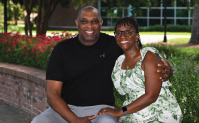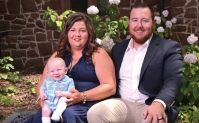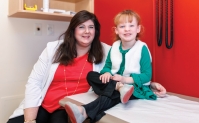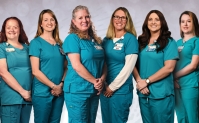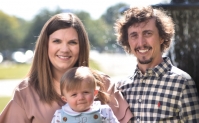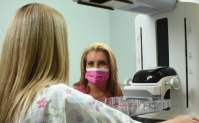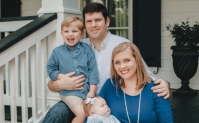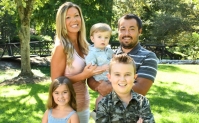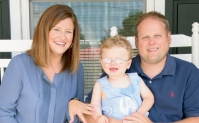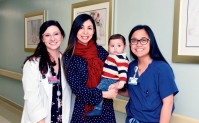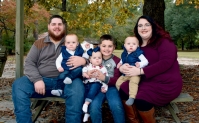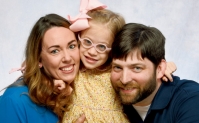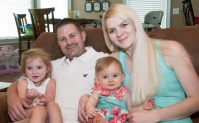You Inspire The Best in Us.
With the many advances in care and treatments, today’s patients have more and more reasons to expect the best outcomes. Here are the incredible stories of our patients and their journeys. Click on a thumbnail and scroll down to view each story.

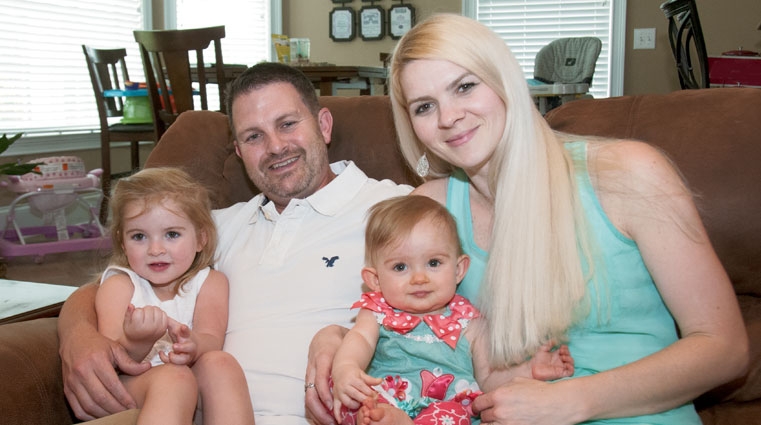
Indiana Burroughs
By Jessica Wall
On May 13, 2015, Brett and Shawn Burroughs of Whiteville, North Carolina, welcomed their second daughter, Indiana, into the world. Named after the infamous character Indiana Jones, Indiana showed all signs of a healthy baby girl.
“Compared to our first child, Piper, Indiana was much calmer and slept more,” recalls Shawn.
Two weeks later, during a routine check-up, Indiana’s pediatrician Dr. Erin Smith discovered a heart murmur.
As a high school coach, I am around many students who have heart murmurs, so Shawn and I were not too concerned at first,” explains Brett.
Dr. Smith immediately referred the Burroughs to Dr. Charles Trant, McLeod Pediatric Cardiologist.
Board certified in pediatric cardiology, Dr. Trant treats children with congenital and acquired heart disease. He conducts evaluations of heart murmurs, chest pain, syncope, palpitations, and arrhythmias. He also performs and interprets pediatric echocardiograms, electrocardiograms, tilt table tests and stress tests.
At the appointment, Dr. Trant performed an EKG and echocardiogram in his office.
The diagnostic testing indicated that Indiana had a Ventricular Septal Defect (VSD), Atrial Septal Defect (ASD), and Patent Ductus Arteriosis (PDA).
“Dr. Trant brought us in and explained that there were a few problems,” recalls Brett. “Shawn and I became very fearful at that point.”
Dr. Trant explained that the heart has two upper chambers (atria) and two lower chambers (ventricles). The right side of the heart -- the right atrium and right ventricle -- pumps blood to the lungs, and the left side of the heart -- the left atrium and left ventricle -- pumps blood to the rest of the body
Atrial Septal Defect is a heart defect where there is a hole in the upper chamber of the heart. As a result, the heart pumps extra blood to the lungs. Similarly, Ventricular Septal Defect is a heart defect where there is a hole in the lower chamber of the heart, which also results in extra blood being pumped to the lungs.
Patent Ductus Arteriosis is a congenital heart defect where the blood vessel that connects the heart’s two major arteries does not close after birth and allows blood to flow into the lungs. This adds stress to the heart and if left untreated, can lead to congestive heart failure.
“Children born with heart defects have either Ventricular Septal Defect or Atrial Septal Defect coupled with the Patent Ductus Arteriosis, but having all three is much less common,” says Dr. Trant. “What hurt Indiana most was that these conditions could cause problems individually, yet all three were contributing to congestive heart failure (CHF).
“At the initial visit, Indiana looked good, but infants with heart defects frequently do at such an early stage. Most infants do not show signs of CHF until approximately six to eight weeks after birth.”
Brett and Shawn continued to monitor Indiana over the next two months and remained diligent with feedings every two hours and frequent weighing.
Indiana gained approximately three pounds in that time, but then her growth stalled for a couple of weeks. Shawn also noticed Indiana grunting during her feedings.
Concerned over these symptoms, Brett and Shawn called Dr. Trant, and he recommended they bring her in for another evaluation, as these were the initial symptoms of CHF.
“Feeding problems are typically the first place we see issues in children with heart problems,” says Dr. Trant. “Drinking a bottle is about the most vigorous exercise for a baby. If the heart is not working well, feedings become more difficult.”
Dr. Trant put Indiana on two medications to treat the CHF, and her condition improved for a short time. When Indiana’s weight stalled again, he slightly adjusted her formula and medications to “buy more time” before considering surgery.
“I try to be appropriately aggressive and medically manage my patients for as long as possible,” explains Dr. Trant. “The benefits of surgery do not always outweigh the risks, so we must ensure a high benefit and low risk to justify open-heart surgery.”
On September 16, 2015, Indiana met what is called “maximum medical benefit,” meaning Dr. Trant did everything he could from a medical standpoint to keep her going, but this was now a surgical problem.
“From the beginning, Shawn and I prepared ourselves for the possibility of surgery, but we were still crushed,” recalls Brett. “Yet, in the midst of what felt like defeat, we understood that this was the best option for Indiana.”
Indiana was transferred for the repair of her Atrial Septal Defect, Ventricular Septal Defect, and Patent Ductus Arteriosis to a facility where these types of specialized surgeries are performed. She tolerated the surgery extr emely well and no longer suffers from heart failure.
“She has recovered like a champ,” says Dr. Trant.
Today, Indiana has a clean bill of health and enjoys the same activities as most one-year-olds -- crawling, playing with balls and anything Minnie Mouse, eating yogurt melts, and playing with her big sister, Piper.
“Thank you cannot adequately describe our appreciation for Dr. Trant,” says Brett. “His compassion and concern for Indiana meant a great deal to us. We had complete trust in him, and he will always be a part of our life. We also find comfort in having these quality services available to us so close to home.”
Indiana will require long-term followup with Dr. Trant, even into adulthood, since adult cardiologists in general do not have training in congenital heart disease.
“Shawn and I consider this entire journey a blessing, and we know this is part of God’s plan for Indiana’s life,” recalls Brett.
Today, the family looks forward to all the adventures in store for Indiana.
-
McLEOD REGIONAL MEDICAL CENTER FLORENCE
843-777-2000 -
McLEOD DARLINGTON
843-777-1100 -
McLEOD DILLON
843-774-4111 -
McLEOD LORIS
843-716-7000 -
McLEOD SEACOAST
843-390-8100 -
McLEOD CHERAW
843-537-7881 -
McLEOD CLARENDON
803-433-3000



-
McLEOD REGIONAL MEDICAL CENTER FLORENCE
843-777-2000 -
McLEOD DARLINGTON
843-777-1100 -
McLEOD DILLON
843-774-4111 -
McLEOD LORIS
843-716-7000 -
McLEOD SEACOAST
843-390-8100 -
McLEOD CHERAW
843-537-7881 -
McLEOD CLARENDON
803-433-3000
 Find a Doctor
Find a Doctor  Locations
Locations  Services
Services 